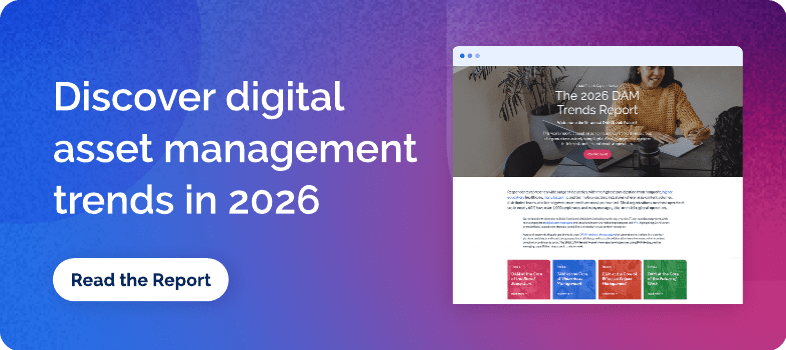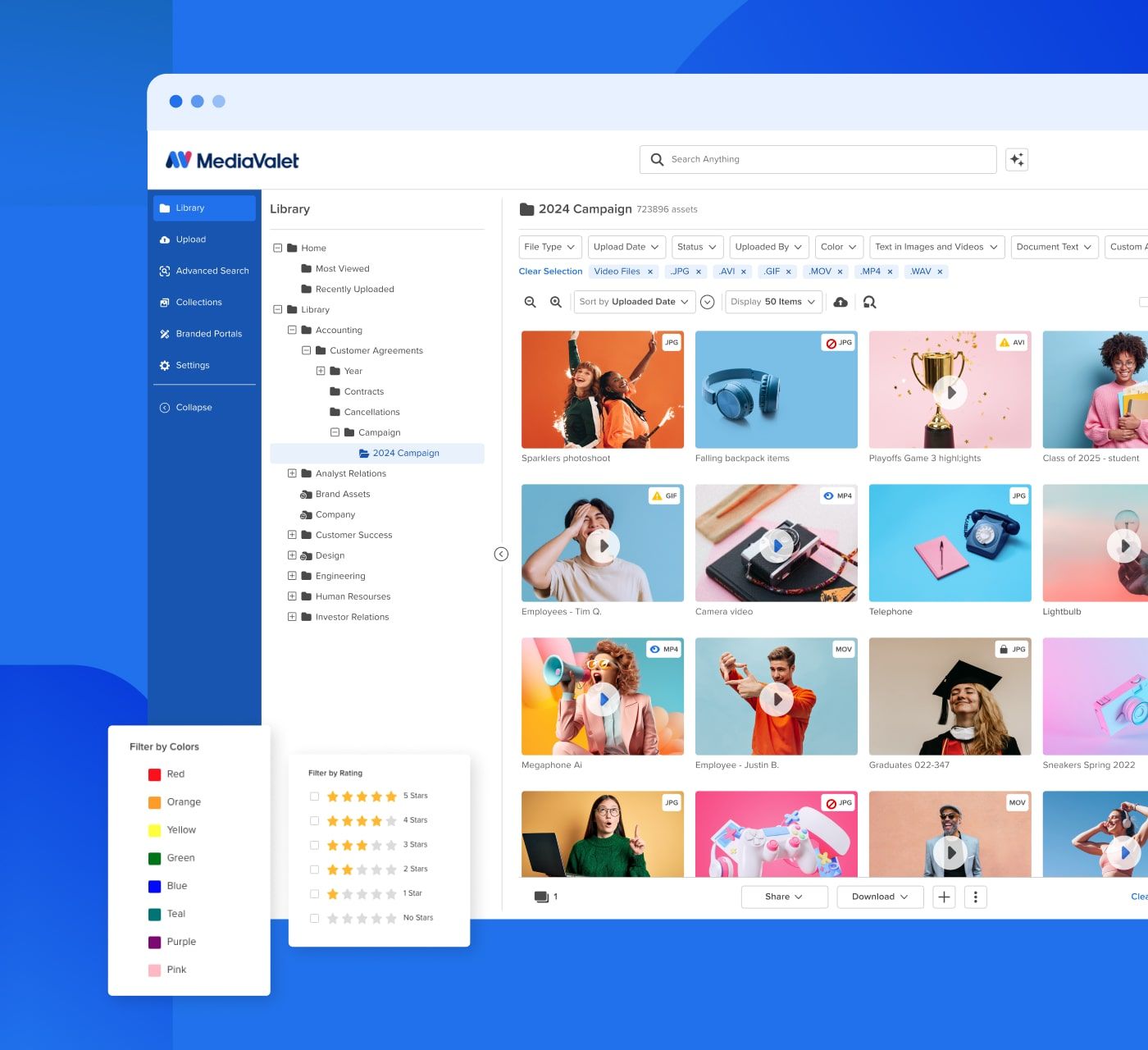Cloud digital asset management (DAM) or cloud-based DAM is an online repository for organizations to store, manage, organize, and distribute digital assets. It enables teams to access digital files seamlessly, allowing employees to collaborate and get work done from anywhere at any time.
The impact of digital transformation
From small businesses to full enterprises, digital transformation is on the radar for most organizations. In fact, 91% of businesses are engaged in some form of digital initiative (Gartner). As organizations continue to embrace digital transformation, many are making the transition from on-premise DAM solutions to the cloud DAM systems.
These transitions have only been expedited by covid-19, as leading organizations were pushed towards cloud-based solutions to address their work-from-home environment. But even now, there are still huge numbers working remotely. Currently, 12.7% of full-time employees work from home, while 28.2% work a hybrid model, but in 2026, 40 million Americans will work remotely.
With this in mind, regardless of whether you work from home, in the office, or a hybrid of both, a cloud-based digital asset management tool is critical for business continuity.

What is Cloud Digital Asset Management (DAM)?
Cloud digital asset management software (DAM) help organizations securely manage, collaborate on, and distribute their high-value digital assets from within one centralized library. It helps teams improve productivity, increase asset ROI and drive revenue growth.
What’s the difference between on-premise DAM and cloud-based digital asset management? Unlike on-premise DAMs, which are stored on physical servers, cloud DAM solutions are hosted in the cloud by a service provider. It typically includes a set-up fee and a monthly or yearly subscription fee that corresponds to your storage and user needs. The provider is responsible for storage, updates, and back-ups, meaning there are no internal hardware or software requirements for the buyer.
You can see a cloud-based DAM in action with our self-guided tour right here:
What are the Benefits of a Cloud DAM?
As more and more organizations find themselves overrun with assets to manage in a safe and secure way, digital asset management workflows are becoming more and more complicated. A digital asset management system (DAM) has never been more important. With a cloud-based DAM, teams are able to:
- Centralized all digital assets,
- Find assets faster,
- Enable content distribution,
- Simplify repurposing content
- Improve brand consistency, and
- Preserve brand history.
Let’s dive into each benefit in more detail.
1. Centralize All Digital Assets
A cloud DAM allows you to store and manage all your digital assets from within one single library, eliminating the need for multiple storage platforms or locations. Centralizing your digital assets helps to establish the organization and improve clarity throughout the entire company. Plus, custom user permissions ensure that everyone in the organization has access to the content relevant to their particular role or project, eliminating confusion and ensuring the proper assets are always used.
2. Find Assets Faster
The advanced search capabilities of a cloud-based DAM eliminate the need to spend time sifting through hundreds or thousands of digital assets, allowing all users to find things quickly and easily. Using a combination of categories, keywords, attributes, artificial intelligence (AI), and advanced search filters, a DAM enables you to find assets based on a wide range of identifiers. This reduces the time spent on manual and administrative tasks giving team members their time back to focus on high-value projects instead.
3. Enable Content Distribution
When assets are ready for distribution, a DAM streamlines this process ensuring the right team members get the right assets. With a DAM, you can easily share large, complex media files with various partners, stakeholders, agencies, vendors, or clients, using share options like web galleries and Branded Portals. Asset distribution can also be automated through integrations, allowing users to access the DAM from within other platforms that they already use and enjoy. Integrations like MediaValet and Wrike, a project management system can streamline workflows to speed up distribution. Permission settings ensure that they can only access content approved for that specific channel.
4. Simplify Repurposing Content
A cloud DAM provides easy access to all previously created media assets, including source files, work-in-progress (WIP), and final assets. This means that content can easily be re-used and repurposed into a variety of other formats, such as videos, advertisements, and more. Plus, categories and keywords ensure that assets are always discoverable down the road — even for team members who didn’t know they existed.
5. Improve Brand Consistency
When everyone across the organization has access to approved, up-to-date assets, it ensures that team members are empowered to represent your brand with confidence. Whether it’s for social media, print marketing, or events, every brand asset is always relevant and consistent. Strong brand consistency helps to better achieve brand recognition and loyalty.
6. Preserve Brand History
A DAM can store a company’s entire asset history, dating back hundreds of years. Decades of campaigns, logos, and more can be stored in one place, ready to be referenced or reused. Since the DAM stores source, work-in-progress (WIP), and final files, they can be easily looked back upon and referenced for future campaigns. This ensures the use of all your assets (which can be expensive to produce) are maximized and no asset is lost or misplaced.
Best Practices for Choosing a Cloud DAM
When it comes time to buy a cloud DAM system, there are 7 key steps to take.
1. Define Goals and Deliverables for the cloud DAM
You need to ensure you understand your organization’s specific needs and the objectives for implementing a DAM system. Are you certain you need a cloud DAM or are there other solutions that would suit your needs better?
2. Identify the Buying Group
It’s important to decide your buying group early on and to gain buy in from all departments and teams that will use the DAM.
3. Evaluate cloud DAM Vendors
Review third party review websites and vendor websites to discover the various DAM solutions available that could meet your organization’s needs.
Interested in learning about different cloud DAM platforms? We’ve detailed how MediaValet measures up against other DAM vendors:
MediaValet vs Bynder
MediaValet vs Canto
MediaValet vs Orange Logic
4. Create a DAM Short List
To save yourself precious time when it comes to demoing, take the time to build a short list of roughly 3 to 5 DAM vendors worth moving forward to the demo phase with.
Frequently Asked Question’s about Cloud-Based DAM Solutions
MediaValet is SOC 2 certified by PwC for security, availability and confidentiality, and leverages Azure data centers which comply with key industry standards, such as ISO/IEC 27001:2013 and NIST SP 800-53, for security and reliability.
MediaValet’s compliance initiatives include conducting vulnerability, penetration and static code testing as part of our SDLC (Secure Development Life Cycle).
MediaValet is GDPR, CCPA and PIPEDA compliant, and can assist customers with their DPA (Data Processing Agreement) requirements.
Interested in learning more about DAM data security, read this blog post.
MediaValet is a 100% cloud-based DAM solution and as such requires little and often no resource obligations from IT to implement. The provisioning and set up of the platform are delivered by MediaValet and typically the only IT involvement required is for enabling SSO.
Depending on the existing location of the digital assets destined for the DAM, IT may be asked to assist in the migration of files from existing servers and storage locations to the new library.
MediaValet offers RESTful Open API to our users, both on the no-cost Developer Plan, as well as the paid Enterprise Developer Plan.
This allows our users to choose how they wish to integrate into their Technology Stack. Users can take advantage of our out-of-the-box connectors on the Web Portal or utilize the API to integrate with various platforms.
MediaValet’s artificial intelligence (AI) takes the heavy lifting out of tagging, searching, and recycling content.
Automatic tagging, Advanced Search, Face Recognition, and Audio Visual Intelligence (AVI), significantly boost the discoverability of your assets without the hard work.
MediaValet is infinitely expandable. Customers have the ability to add unlimited users and user groups, and have access to unlimited product training, and support.
A MediaValet DAM grows with you to meet your needs when you need them met.
DAM pricing varies widely depending on the vendor, features, storage, and number of users. Most vendors use a custom-quote model, so the final cost depends on your organization’s needs.
Click here if you’re interested in MediaValet’s pricing.
The biggest cost drivers are:
– Number of users or whether pricing is unlimited vs per-seat
– Storage capacity (especially for video-heavy libraries)
– Advanced features (AI tagging, video management, portals, integrations)
– Implementation, migration, and training costs
– Ongoing support and maintenance fees
You can get a personalized DAM pricing quote right here.
Get Ahead with a Cloud-Based DAM
It’s clear that cloud-based DAM solutions offer several benefits to help organizations maximize their success as a company. If you’re ready to get started, you can learn more about why MediaValet is the preferred cloud-based DAM vendor for leading organizations in our latest G2 DAM Vendor Comparison report. Download your copy today.
Related Articles
Ready to see what the DAM hype’s about?
Meet with one of our product experts




